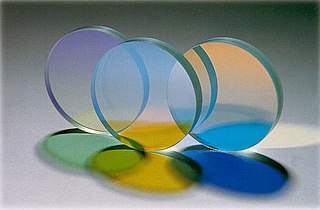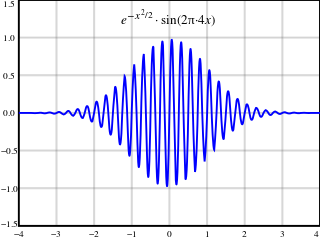Related Research Articles

Nonlinear optics (NLO) is the branch of optics that describes the behaviour of light in nonlinear media, that is, media in which the polarization density P responds non-linearly to the electric field E of the light. The non-linearity is typically observed only at very high light intensities (when the electric field of the light is >108 V/m and thus comparable to the atomic electric field of ~1011 V/m) such as those provided by lasers. Above the Schwinger limit, the vacuum itself is expected to become nonlinear. In nonlinear optics, the superposition principle no longer holds.

Optics is the branch of physics that studies the behaviour and properties of light, including its interactions with matter and the construction of instruments that use or detect it. Optics usually describes the behaviour of visible, ultraviolet, and infrared light. Light is a type of electromagnetic radiation, and other forms of electromagnetic radiation such as X-rays, microwaves, and radio waves exhibit similar properties.

In optics, the refractive index of an optical medium is a dimensionless number that gives the indication of the light bending ability of that medium.

An interference filter, dichroic filter, or thin-film filter is an optical filter that reflects some wavelengths (colors) of light and transmits others, with almost no absorption for all wavelengths of interest. An interference filter may be high-pass, low-pass, bandpass, or band-rejection. They are used in scientific applications, as well as in architectural and theatrical lighting.
Q-switching, sometimes known as giant pulse formation or Q-spoiling, is a technique by which a laser can be made to produce a pulsed output beam. The technique allows the production of light pulses with extremely high (gigawatt) peak power, much higher than would be produced by the same laser if it were operating in a continuous wave mode. Compared to modelocking, another technique for pulse generation with lasers, Q-switching leads to much lower pulse repetition rates, much higher pulse energies, and much longer pulse durations. The two techniques are sometimes applied together.
Mode locking is a technique in optics by which a laser can be made to produce pulses of light of extremely short duration, on the order of picoseconds (10−12 s) or femtoseconds (10−15 s). A laser operated in this way is sometimes referred to as a femtosecond laser, for example, in modern refractive surgery. The basis of the technique is to induce a fixed phase relationship between the longitudinal modes of the laser's resonant cavity. Constructive interference between these modes can cause the laser light to be produced as a train of pulses. The laser is then said to be "phase-locked" or "mode-locked".
Optics is the branch of physics which involves the behavior and properties of light, including its interactions with matter and the construction of instruments that use or detect it. Optics usually describes the behavior of visible, ultraviolet, and infrared light. Because light is an electromagnetic wave, other forms of electromagnetic radiation such as X-rays, microwaves, and radio waves exhibit similar properties.

In the field of optics, transparency is the physical property of allowing light to pass through the material without appreciable scattering of light. On a macroscopic scale, the photons can be said to follow Snell's law. Translucency allows light to pass through but does not necessarily follow Snell's law; the photons can be scattered at either of the two interfaces, or internally, where there is a change in the index of refraction. In other words, a translucent material is made up of components with different indices of refraction. A transparent material is made up of components with a uniform index of refraction. Transparent materials appear clear, with the overall appearance of one color, or any combination leading up to a brilliant spectrum of every color. The opposite property of translucency is opacity. Other categories of visual appearance, related to the perception of regular or diffuse reflection and transmission of light, have been organized under the concept of cesia in an order system with three variables, including transparency, translucency and opacity among the involved aspects.
The photorefractive effect is a nonlinear optical effect seen in certain crystals and other materials that respond to light by altering their refractive index. The effect can be used to store temporary, erasable holograms and is useful for holographic data storage. It can also be used to create a phase-conjugate mirror or an optical spatial soliton.

Kerr-lens mode-locking (KLM) is a method of mode-locking lasers via the nonlinear optical Kerr effect. This method allows the generation of pulses of light with a duration as short as a few femtoseconds.
The Kerr effect, also called the quadratic electro-optic (QEO) effect, is a change in the refractive index of a material in response to an applied electric field. The Kerr effect is distinct from the Pockels effect in that the induced index change for the Kerr effect is directly proportional to the square of the electric field instead of varying linearly with it. All materials show a Kerr effect, but certain liquids display it more strongly than others. The Kerr effect was discovered in 1875 by Scottish physicist John Kerr.
Cavity ring-down spectroscopy (CRDS) is a highly sensitive optical spectroscopic technique that enables measurement of absolute optical extinction by samples that scatter and absorb light. It has been widely used to study gaseous samples which absorb light at specific wavelengths, and in turn to determine mole fractions down to the parts per trillion level. The technique is also known as cavity ring-down laser absorption spectroscopy (CRLAS).

In physics, absorption of electromagnetic radiation is how matter takes up a photon's energy — and so transforms electromagnetic energy into internal energy of the absorber.

An optical fiber, or optical fibre, is a flexible glass or plastic fiber that can transmit light from one end to the other. Such fibers find wide usage in fiber-optic communications, where they permit transmission over longer distances and at higher bandwidths than electrical cables. Fibers are used instead of metal wires because signals travel along them with less loss and are immune to electromagnetic interference. Fibers are also used for illumination and imaging, and are often wrapped in bundles so they may be used to carry light into, or images out of confined spaces, as in the case of a fiberscope. Specially designed fibers are also used for a variety of other applications, such as fiber optic sensors and fiber lasers.

A frequency comb or spectral comb is a spectrum made of discrete and regularly spaced spectral lines. In optics, a frequency comb can be generated by certain laser sources.

Acousto-optics is a branch of physics that studies the interactions between sound waves and light waves, especially the diffraction of laser light by ultrasound through an ultrasonic grating.

In nonlinear optics z-scan technique is used to measure the non-linear index n2 and the non-linear absorption coefficient Δα via the "closed" and "open" methods, respectively. As nonlinear absorption can affect the measurement of the non-linear index, the open method is typically used in conjunction with the closed method to correct the calculated value. For measuring the real part of the nonlinear refractive index, the z-scan setup is used in its closed-aperture form. In this form, since the nonlinear material reacts like a weak z-dependent lens, the far-field aperture makes it possible to detect the small beam distortions in the original beam. Since the focusing power of this weak nonlinear lens depends on the nonlinear refractive index, it would be possible to extract its value by analyzing the z-dependent data acquired by the detector and by cautiously interpreting them using an appropriate theory. To measure the imaginary part of the nonlinear refractive index, or the nonlinear absorption coefficient, the z-scan setup is used in its open-aperture form. In open-aperture measurements, the far-field aperture is removed and the whole signal is measured by the detector. By measuring the whole signal, the beam small distortions become insignificant and the z-dependent signal variation is due to the nonlinear absorption entirely. Despite its simplicity, in many cases, the original z-scan theory is not completely accurate, e.g. when the investigated sample has inhomogeneous optical nonlinear properties, or when the nonlinear medium response to laser radiation is nonlocal in space. Whenever the laser induced nonlinear response at a certain point of the medium is not solely determined by the laser intensity at that point, but also depends on the laser intensity in the surrounding regions, it will be called a nonlocal nonlinear optical response. Generally, a variety of mechanisms may contribute to the nonlinearity, some of which may be nonlocal. For instance, when the nonlinear medium is dispersed inside a dielectric solution, reorientation of the dipoles as a result of the optical field action is nonlocal in space and changes the electric field experienced by the nonlinear medium. The nonlocal z-scan theory, can be used for systematically analyzing the role of various mechanisms in producing the nonlocal nonlinear response of different materials.

A photonic metamaterial (PM), also known as an optical metamaterial, is a type of electromagnetic metamaterial, that interacts with light, covering terahertz (THz), infrared (IR) or visible wavelengths. The materials employ a periodic, cellular structure.
A nonlinear metamaterial is an artificially constructed material that can exhibit properties not yet found in nature. Its response to electromagnetic radiation can be characterized by its permittivity and material permeability. The product of the permittivity and permeability results in the refractive index. Unlike natural materials, nonlinear metamaterials can produce a negative refractive index. These can also produce a more pronounced nonlinear response than naturally occurring materials.
A parametric process is an optical process in which light interacts with matter in such a way as to leave the quantum state of the material unchanged. As a direct consequence of this there can be no net transfer of energy, momentum, or angular momentum between the optical field and the physical system. In contrast a non-parametric process is a process in which any part of the quantum state of the system changes.
References
- ↑ Gibbs, Hyatt (1985). "Introduction to Optical Bistability". Optical Bistability: Controlling Light With Light. Quantum electronics--principles and applications. Orlando, FL: Academic Press Inc. p. 1. ISBN 978-0122819407 . Retrieved June 16, 2021.
- ↑ Goldstone, J. A., and E. Garmire. "Intrinsic optical bistability in nonlinear media". Physical review letters 53.9 (1984): 910. https://doi.org/10.1103/PhysRevLett.53.910
- ↑ Sharif, Morteza A., et al. "Difference Frequency Generation-based ultralow threshold Optical Bistability in graphene at visible frequencies, an experimental realization". Journal of Molecular Liquids 284 (2019): 92–101. https://doi.org/10.1016/j.molliq.2019.03.167
- Guangsheng He; Song H. Liu (1999). Physics of Nonlinear Optics. World Scientific. pp. 422–. ISBN 978-981-02-3319-8.